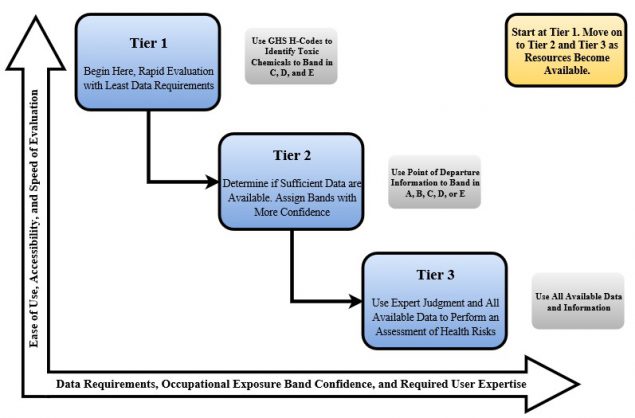NIOSH Research Rounds
Note to our readers: In the interest of streamlining our communication materials, we are combining Research Rounds and eNews into one monthly newsletter. Beginning in October, look for a new and concise Research Rounds section within your monthly issue of NIOSH eNews.
NIOSH Research Rounds is a monthly bulletin of selected research conducted by researchers at NIOSH and NIOSH-funded researchers at other institutions.
Volume 5, Number 2 (August 2019)
Inside NIOSH:
Occupational Exposure Banding Assesses Chemical Hazards

Occupational exposure banding uses three tiers to classify chemical hazards based on available information about potential health effects. Photo from NIOSH.
- John Howard, M.D., Director
- Christina Spring, Editor in Chief
- Anne Blank, Managing Editor
- Donjanea Williams, Contributing Editor
- Sarah Mitchell, Contributing Editor
- Jeanette Novakovich, Copy Editor
- Tonya White, Web Developer
To receive the NIOSH Research Rounds email newsletter, enter your email address:
The gold standard for assessing and controlling work-related chemical exposure is the occupational exposure limit, or OEL. While more than 85,000 chemicals are commercially available, according to the U.S. Environmental Protection Agency, only about 1,000 chemicals have an authoritative OEL. As new chemicals are developed and introduced into commerce, the number of chemicals without OELs increases.
To inform chemical risk management in the workplace, NIOSH developed an approach called occupational exposure banding, described in a new report, The NIOSH Occupational Exposure Banding Process for Chemical Risk Management, and an accompanying Occupational Exposure Banding e-Tool (e-Tool). Occupational exposure banding is an innovative, voluntary approach that uses information about a chemical’s toxicity and health effects to classify it into an appropriate occupational exposure band (OEB). The process is divided into three tiers, with each tier dependent upon available information for the chemical and user expertise. Users can enter information about a chemical into the e-Tool, which then classifies the chemical into one of five concentrations expected to protect worker health, from the highest exposure range concentration in Band A, associated with less serious health effects, to the lowest exposure range recommendation in Band E, associated with more serious health effects.
Scientists tested the process and e-Tool on chemicals with OELs and found that the results were accurate, reproducible, and protective because indicated recommended levels of airborne exposures were at least as protective as the established OELs. Accordingly, NIOSH and users can have confidence in the process as a reliable alternative for assessing chemical hazards. Although not intended to replace OELs when available, it is a starting point to inform risk management decisions when an OEL is not available.
More information is available:
Outside NIOSH:
Workers’ Compensation Records Identify Risk for Carpal Tunnel Syndrome
Workers who produce clothing, process food, or perform administrative work had the highest rates of work-related carpal tunnel syndrome (CTS) in California, according to NIOSH-funded research published in CDC’s Morbidity and Mortality Weekly Report (MMWR).
CTS is a musculoskeletal disorder that develops when repetitive, forceful motion causes pressure on a nerve in the wrist. Workers with CTS often experience pain, tingling, weakness, and numbness in their hand.
To identify workers at risk, the NIOSH-funded occupational health and safety surveillance program in the California Department of Public Health reviewed state workers’ compensation claims between 2007 and 2014. Researchers analyzed an average of 637,672 claims for each year for reported CTS cases, noting demographics, such as gender and age, and industry and occupation. They then calculated the CTS rate for employees working at least 40 hours weekly. Women experienced CTS at a rate three times that of men. The highest risk was among workers in production, material moving, and office and administrative support. During the 7-year period, 139,336 claims were related to CTS, equaling 6.3 cases per 10,000 workers. These findings show that workers’ compensation claims can identify high-risk jobs for CTS and other injuries and could help other states focus on ergonomic interventions to design tasks and equipment that minimize the risk to workers.
More information is available:
Verbal Abuse of Home Care Aides Common Problem
The number of home care aides is rapidly growing, expecting to account for 1.2 million new U.S. jobs by 2026. These workers support clients with self-care and mobility in their homes and can face physical and verbal abuse because of the isolated nature of their work and limited support. Such violence can lead to depression, physical burnout, and high job turnover.
Most studies on violence in healthcare focus on hospitals and other facility-based settings. To fill this research gap, a NIOSH-funded study published in the journal Occupational & Environmental Medicine looked into home care aides’ experiences of verbal abuse and related risk factors. Researchers at the University of Massachusetts Lowell collected information from 954 home care workers through surveys, focus groups, and interviews between September 2012 and April 2013. The researchers asked participants about working conditions within the past year, including verbal abuse from clients and their relatives, health, as well as job security. Researchers also collected information on age, race, and other demographics.
Results showed that 22% of participants reported verbal abuse at least once in the past 12 months and that those who experienced verbal abuse were 11 times more likely to have experienced physical abuse. Researchers identified clients with dementia and inadequate workspace in a client’s home as important risk factors for verbal abuse. Unclear plans for delivering care and clients with limited mobility also were associated with verbal abuse, although to a lesser extent. In contrast, predictable work schedules lowered the risk and, according to the researchers, could possibly improve the relationship between home care aides and clients. These findings support the need for policy and training interventions targeting violence against home care aides.
More information is available:
Mention of any company or product does not constitute endorsement by NIOSH.
